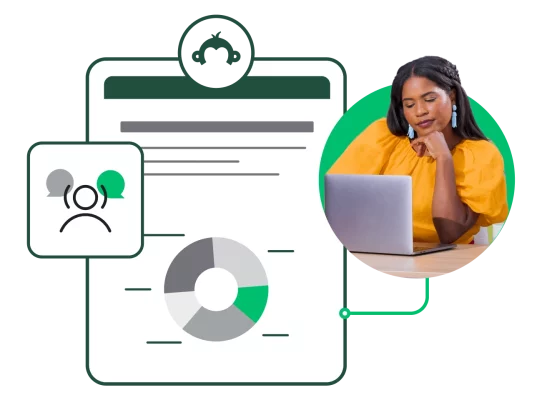What is word-of-mouth marketing and how to use it
Word-of-mouth marketing (WOM marketing) occurs when customers love your products and services enough to recommend them. Learn how to generate and leverage WOM with SurveyMonkey.

- Word-of-mouth marketing is free advertising driven by customers' love for your business, prompting them to recommend you to family, friends, and colleagues.
- WOM marketing builds trust and credibility through personal recommendations, often leading to higher customer loyalty and increased business.
- Word-of-mouth marketing benefits businesses by generating organic, trusted endorsements that can significantly boost brand awareness, customer loyalty, and sales with minimal cost.
Every business wants a stream of natural traffic that brings new potential customers directly to it. Word-of-mouth marketing is one of the most effective ways of doing this.
Word-of-mouth marketing demonstrates that your business satisfies its customers to such a degree that they’re willing to tell friends, family, and colleagues.
In this article, we’ll explore the power of word-of-mouth marketing, touch on the types of WOM marketing, and outline how to generate this form of marketing for your business.
What is word-of-mouth marketing?
Word-of-mouth marketing is a form of free advertising where a customer’s love for your business propels them to recommend you to family, friends, and colleagues. Generating word-of-mouth marketing is less about launching a marketing campaign and more about building a brand and products with a high level of customer satisfaction.
When your customers enjoy your business and its products, they’re likelier to share a positive recommendation with those they’re close to. Considering that consumers are more likely to trust a recommendation from a friend rather than an advertisement, word-of-mouth marketing can be a powerful method of customer acquisition.
As current market research shows that people are bombarded with advertisements, the role of word-of-mouth marketing will only become more impactful.
Why is word-of-mouth marketing important?

When your business naturally begins to generate word-of-mouth marketing, you’re probably doing something right. WOM marketing only starts when people trust your brand enough to share their experience with others. With that in mind, striving for word-of-mouth marketing can be a good benchmark to show that the customer experience you offer is satisfying.
Beyond being a marker of a successful customer experience program, word-of-mouth marketing is important as it offers the following benefits to your business:
- Improve brand loyalty: Word-of-mouth marketing allows you to leverage your customers' connections to create relationships with new customers. People will trust your business more from the beginning of your relationship, leading to better customer relationships in less time.
- Enhance brand reputation: Word-of-mouth marketing occurs when your business delivers winning customer experiences to your consumers. When people enjoy your company enough to tell others, you’ll begin to improve your brand reputation. After all, if people give positive recommendations to their friends, you’re starting a new customer relationship from an advantageous position.
- Decrease customer acquisition costs (CAC): When you naturally bring in a new customer by referral, you’ve obtained a new customer essentially for free. Word-of-mouth marketing is a cost-effective way of bringing in new leads to decrease your business's CAC.
Across these benefits, word-of-mouth marketing is a highly effective form of marketing that every business should strive to establish in their company.
Types of word-of-mouth marketing
Not all word-of-mouth marketing is the same. While each type may have a similar impact, they differ in the channels, people involved, and structure of the positive recommendation.
Here are a few examples of word-of-mouth marketing to understand:
- Referral programs: Word-of-mouth referral marketing programs are structured reward schemes that incentivize customers to share your business.
- Brand ambassador: Brand ambassador marketing involves giving someone special privileges in your business in return for them recommending or selling your services or products. These people will champion your brand and let the world know you're great.
- Affiliate marketing: Affiliate marketing is similar to referral programs but rewards affiliated people with a percentage of the total cost of a sale. It tracks how customers arrive on your site. If they come through an affiliate's referral link, they are rewarded.
- Customer reviews: Customer reviews are the social proof many businesses need to prove themselves to the broader consumer market. Every time someone posts a review, they generate word-of-mouth marketing for others to see.
- Personal recommendations: Personal recommendations are the most natural form of word-of-mouth marketing. They emerge when customers love your brand and want their friends to have the same positive customer experience.
No one form of word-of-mouth marketing is more effective than the others. Each will increase your business's brand visibility and enhance social proof.
Related reading: Marketing trends: 3 strategies marketers are prioritizing in 2024.
How to generate word-of-mouth marketing

Generating word-of-mouth advertising won’t happen overnight. On the contrary, this is one of the most complex marketing strategies, as it has more to do with your customers than your marketing teams.
However, your business can use several strategies to improve customers' likelihood of sharing your company with friends and family.
Offer exceptional customer service
Customer service makes or breaks word-of-mouth marketing. Delivering a world-class customer experience is the best way to inspire your customers to tell a friend about your business or leave a shining review.
One of the best ways to improve your customer service is to request feedback from your consumers. Sending customer service feedback surveys will help you better understand how well your teams perform and identify areas for improvement.
By collecting feedback from your customers, you can improve pain points. Over time, by creating a feedback loop, you’ll create a highly streamlined and effective customer service system.
Additionally, you will demonstrate to your customers that you take their feedback seriously, inspiring loyalty and word-of-mouth marketing.
Related reading: The ultimate guide to customer service.
Gather social proof
Social proof is one of the most fundamental factors that will help prove the authenticity of your business online. Instead of just blindly trusting a business, social proof allows a customer to see verified testimonials and reviews of your products before they buy. By browsing through these reviews, a customer can get a sense of what the product is like and hear from customers who already have experience with your products.
Where possible, ensure your customers have the opportunity to leave social proof for your business. You can use review boxes on product pages or even directly solicit a review from a customer after they’ve purchased a product or service.
Another effective way of gathering social proof is to use a proof points survey. These surveys allow you to request feedback on your current products while also giving customers the opportunity to highlight what they like best about your services.
The more social proof that your business has, the more likely someone is to trust your business. With that in mind, social proof can be an effective form of word-of-mouth advertising that is accessible and easy to create.
Build a VoC program
Building a Voice of the Customer (VoC) program allows your business to systematically collect data from your customers, monitor interactions with your brand, and identify potential issues in the customer journey.
A VoC program is a company-wide effort that empowers your employees to give your customers the best possible experience. Over time, a great VoC program will help improve the customer experience, enhance employee engagement, and provide a competitive advantage in your industry.
As you iterate and improve upon the customer experience you offer, you’ll begin to satisfy your customers and receive more word-of-mouth advertising.
There are also a whole host of customer surveys that you can use to measure your brand perception and gather feedback on your customer experience:
- Brand perception survey: Measure how your customers perceive your brand and understand your target audience.
- Brand performance survey: Discover what motivates your customers to engage with your brand and buy your products.
- Brand tracking survey: Gather information on your brand’s overall health, including market insight, company strategy, and more.
The more information you gather from your customers, the better equipped you’ll be with data to take action and create a streamlined customer experience.
Related reading: Measure brand health to maximize growth for your business.
Frequently asked questions
How to drive word-of-mouth marketing?
Businesses can drive word-of-mouth marketing by collecting customer feedback, identifying challenges in the customer journey, and fixing them to create a better customer experience.
When customers are satisfied with your brand, they’ll be more likely to recommend you. Therefore, improving your customer experience and streamlining their journey with your business should be a top priority.
How does word-of-mouth affect consumer behavior?
Word-of-mouth marketing helps improve consumer-business relationships. New customers who arrive through WOM marketing will already have a heightened opinion and level of trust in your business. Word-of-mouth marketing improves your customer relationships and allows you to streamline the customer journey.
How can you use word-of-mouth as a marketing tool?
Word-of-mouth marketing is an effective marketing tool as it enhances customer relationships, decreases the cost of acquisition, and generates an organic stream of new customers.
By generating different types of WOM marketing, like referral schemes, affiliate programs, and more, a business can improve its management of word-of-mouth marketing.
Leverage word-of-mouth marketing
Word-of-mouth marketing can be an incredibly powerful way to improve customer relationships and generate new customers. As a byproduct of great customer experiences, WOM marketing is a win-win, as you’ll improve the customer journey while also seeing improved returns from this form of marketing.
Leverage SurveyMonkey to enhance your customer experiences. Get tailored, data-driven feedback that you can use to identify problem touchpoints and remedy them. Get started today with SurveyMonkey.
Discover more resources

Understand your target market to fuel explosive brand growth
Brand marketing managers can use this toolkit to understand your target audience, grow your brand, and prove ROI.

Customer Behavior Analysis: A Complete Guide and Examples
Read our step-by-step guide on conducting customer behavior analysis. Learn how to collect data and improve customer touchpoints.

Survey Analysis Report: How to Create, Tips & Examples
Presenting your research soon? Learn the most effective way to use a survey analysis report. See sections to include and report best practices.

What is agile market research and how to use it
Conduct market research faster for real-time insights and smart decision-making. Learn what agile market research is and how to apply the framework.